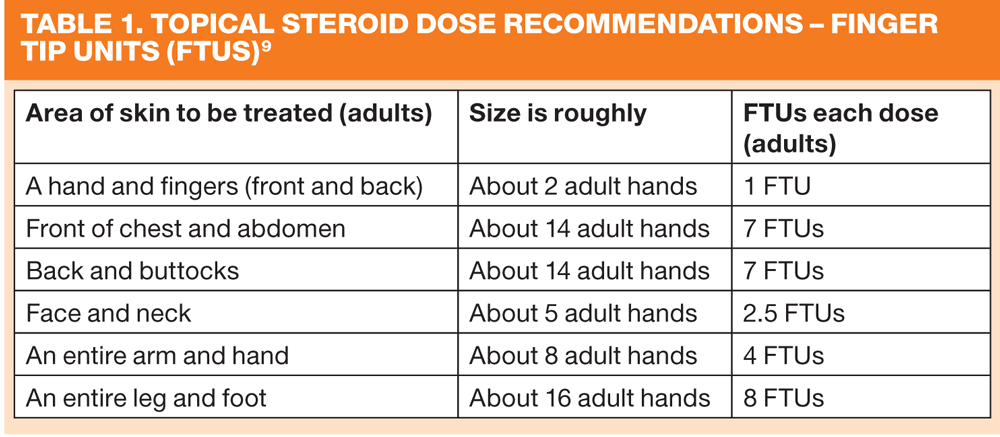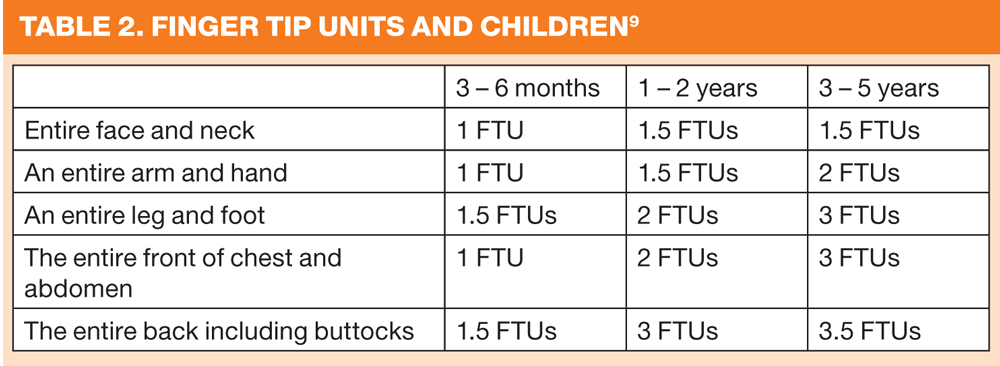Effective management of atopic eczema
Mandy Galloway
Mandy Galloway
Editor
Emollients are the mainstay of therapy for atopic eczema but when and how should they be applied? Practice Nurse reviews the latest guidance for some practical tips
Emollients have been used for more than 5,000 years and play an essential role in the management of all dry skin conditions, including atopic and contact eczema. They are, broadly speaking, a safe and effective option, and most cases of mild to moderate eczema can be managed using emollients alone.1
Without emollients it is not possible to manage atopic eczema effectively.2 So why then, for some of the 5 million children and adults affected by eczema, do emollients seem to offer less than adequate relief?
The key factor in the efficacy of emollient therapy is consistency of use: they must be applied liberally, frequently and regularly — at least three times a day, every day and more often — up to once an hour — for very dry skin.1
BACKGROUND
Atopic eczema is an inflammatory condition, which is characterised by dry skin, an intermittent pattern of flares that may occur rapidly and last anything from a few days to several weeks, and periods of remission.3
The true prevalence is difficult to ascertain, as epidemiological studies vary in their criteria — some use parent-reported eczema and do not state whether or not the eczema was atopic; others use school medical officer reported cases, which tends to result in a lower prevalence, but it is estimated that the condition affects between 5% and 11% of children under 13 years. Prevalence has been found to be higher in black Caribbean children than white children, but again the figures lack certainty because of variations in diagnostic criteria.3
Recent reports suggest that the prevalence of this and other atopic conditions is increasing, and that this may be linked to consumption of certain food groups, loosely described as 'fast foods'.4
The incidence of eczema is highest in the first 6 months of life (21%) falling to 3.8% by 30 months. Children who develop eczema during the first year of life are more likely to be severely affected, but most children treated in the community have disease of mild severity, with only 1-2% with severe disease.3 Around 40% of children will 'grow out' of eczema — one study of children in Germany found that 43% were in complete remission by the age of 3 years, and only 19% had symptoms every year up to the age of 7 years. Nonetheless, for many people, eczema persists into adulthood.1
DIAGNOSIS
There are no specific markers or tests to confirm diagnosis, which is made on the basis of assessment of clinical features.3 These include:
- Visible flexural dermatitis (e.g. bends of elbows, behind the knees) or visible dermatitis on the cheeks of children aged 18 months or under
- Personal history of flexural dermatitis
- Personal history of dry skin in the last 12 months
- Personal history of asthma or allergic rhinitis (or history of atopic disease in a first degree relative of children under age 4 years)
- Onset of signs and symptoms under the age of 2 years (not a valid criterion in children aged under 4 years)
The major diagnostic feature is itchy skin in combination with the presence of three or more of the other criteria.3
MANAGEMENT
Effective management requires the investment of time by the practice nurse to allow adequate discussion with the patient or parent (or carer), to advise on how best to use emollients, and to provide an individualised management plan. At every step, it is vital to ensure that the patient understands the need to adhere to treatment, and to make sure that emollients are being used in copious quantities.2
Emollients are simply moisturisers, but unlike cosmetic moisturisers, they are generally unperfumed and have no additional properties such as sunscreens or anti-ageing ingredients. They are available in various formats, which vary in their acceptability to patients and ease of use:
- Lotions — spread easily, are quickly absorbed and are cooling, but less effective than creams and ointments. Useful for hairy areas.
- Creams — easier to spread over sore skin and usually non-greasy, but contain preservatives to which sensitivity can develop
- Ointments — usually preservative-free, ointments are usually stiff and greasy, and some patients find them difficult to apply or cosmetically unacceptable, but they are very effective at retaining moisture in the skin and are useful for very dry or thickened skin
- Soap substitutes — used instead of soap, which is alkaline and very drying to skin, or detergent-based bath/shower products which can be irritant, emollient soap substitutes are effective skin cleansers, although the absence of lather may take some getting used to!
- Aqueous cream — designed as a cleansing agent, aqueous cream is also widely used as a leave-on emollient. However, the MHRA has recently issued a drug safety update (March 2013) advising against this use, as it may cause local skin reactions such as stinging, burning, itching and redness, possibly due to sodium lauryl sulfate content.5
Although aqueous cream is useful as a leave-on emollient in a substantial proportion of patients with eczema, it is known to cause skin reactions in some patients, especially children. An audit of 100 children attending a paediatric dermatology clinic reported that aqueous cream emollient was associated with an immediate reaction, i.e. within 20 minutes, in 56% of exposures compared with 18% of exposures to other emollients.6 Other studies have reported alterations in skin physiology (thinning of outermost layer and increased water loss).7,8 The MHRA has not banned aqueous cream as a leave-on emollient, but advises healthcare professionals to warn patients that they may develop adverse skin reactions, and if they do, to discontinue use immediately and switch to an alternative product.5
HOW AND WHEN TO APPLY
The best emollient is the one that the patient or parent will use.2 Using a combination of lotions, creams and ointments helps to give the best hydration and to restore skin barrier function.1
Ideally, emollients should be applied several times a day — at least three or four times — and in copious amounts. Make sure than when you prescribe emollients, you provide sufficient — some patients will get through a 500g tub in a week.
Emollients should be applied gently, in the direction of hair growth (think stroking rather than rubbing) to avoid damage to the follicles, which could leave the skin vulnerable to infection. Ideally, they should be applied after bathing (with a soap substitute) while water is still trapped on the skin surface for additional hydration.
Advise patients/parents not to put their fingers into the container, but to use a spatula to remove the quantity needed, to avoid cross-contamination. They should continue to use an emollient even when a flare has subsided to help maintain remission.
Emollients and topical steroids
The Primary Care Dermatology Society has recently revised its guideline on the management of atopic eczema, (March 2013) and recommends that when both emollients and topical steroids are used, the emollient should be applied first and left to absorb for 20 minutes before the steroid is used.2
Use the lowest potency steroid that is effective.2 The strength of steroid should be determined by the age of the patient, the site of the inflammation, and its severity, ranging from 1% hydrocortisone for a child's face to potent or very potent, e.g. clobestasol proprionate 0.05% for the palms or soles. Generally speaking, the PCDS recommends that it is more effective and safer to use more potent treatments for a few days than to use less potent treatments over a longer period of time.
Steroid atrophy is uncommon when steroids are used appropriately, but topical steroids should be avoided around the eyes because of the risk of glaucoma. Regular use of topical steroids on the face should generally be avoided, and also avoided on the lower legs of older patients or those at risk of leg ulcers.2
Topical steroids should be applied thinly, and only to inflamed skin.2 The unit of measurement is the finger tip unit, i.e. the amount of topical steroid that can be squeezed out of a standard tube with a 5mm nozzle along an adult's fingertip, from the end of the finger to the first crease.9 (See Tables 1 & 2) If it seems that patients are using too much, or there are signs of atrophy, it may be time to consider treatment with a topical immunomodulator, tacrolimus or pimecrolimus,2 both of which are recommended by NICE for adults and children aged 2 years and over as a second-line treatment.10
SPECIAL CIRCUMSTANCES
The PCDS guideline also includes helpful advice for the management of atopic eczema in particular circumstances.
Infection
If the skin appears infected and the flare-up is widespread, or there are areas of weeping or crusted eczema, consider a 1-week course of a systemic antibiotic. If localised, a topical combination product (steroid plus antibiotic) is indicated.
For marked sleep disturbance as a result of itching, a sedating antihistamine can be helpful — non-sedating antihistamines are generally only useful if the patient also has allergic rhinitis to contend with.
Some patients find wet wraps soothing, but there is no good evidence to support their use, and bandages or dressings should not be used on wet, infected eczema.
Frequent flares
If the patient is experiencing frequent flares, the first step is to check adherence to treatment. Consider the steroid weekend regime — once eczema is under control, use a topical steroid on the areas that tend to flare for two consecutive days each week (e.g. Saturday and Sunday), even if the skin is not inflamed, to reduce the frequency of flare-ups.
If infection appears to be occurring frequently, swab the skin and also take a nasal swab: if positive for staphylococcus Aureus, treat the nasal infection with an appropriate topical preparation.
CONCLUSION
Eczema can be a debilitating, miserable condition, but with careful management it does not have to be. There is much that practice nurses can do to ensure that patients or parents are aware of the importance of effective emollient regimes, which should help to control the inflammation and reduce the need for topical steroid therapy in mild-to-moderate disease.
REFERENCES
1. National Eczema Society. Emollients — Factsheet. Available at www.eczema.org
2. Primary Care Dermatology Society UK. Eczema: atopic eczema. Available at: www.pcds.org.uk/clinical-guidance/atopic-eczema
3. NICE. Atopic eczema in children. CG57. Available at http://www.nice.org.uk/nicemedia/live/11901/38559/38559.pdf
4. Ellwood P, Asher MI, Garcia-Marcos L, et al for the ISAAC Phase III study group. Do fast foods cause asthma, rhinoconjunctivitis and eczema. Global findings from the International Study of Asthma and Allergies in Childhood (ISAAC) Phase Three. Thorax Online First, January 2013; doi:10.1136/thoraxjnl-2012-202285
5. MHRA. Aqueous cream: may cause skin irritation, particularly in children with eczema, possibly due to sodium lauryl sulfate content. Drug Safety Update 2013; 6(8)
6. Cork MJ et al. An audit of adverse drug reactions to aqueous cream in children with atopic eczema. Pharm J 2003;271:747
7. Tsang M, Guy RH. Effect of aqueous cream BP on human stratum corneum in vivo. Br J Dermatol 2010;163:954-58
8. Danby SG et al. The effect of aqueous cream BP on the skin barrier in volunteers with a previous history of atopic dermatitis. Br J Dermatol 2011;165:329-34
9. Patient.co.uk Fingertip units for topical steroids. Available at www.patient.co.uk/health/fingertip-units-for-topical-steroids
10. NICE. Tacrolimus and pimecrolimus for atopic eczema: technology appraisal guidance 82. 2004. Available at http://guidance.nice.org.uk/TA82/QuickRefGuide/pdf/English
Related articles
View all Articles


